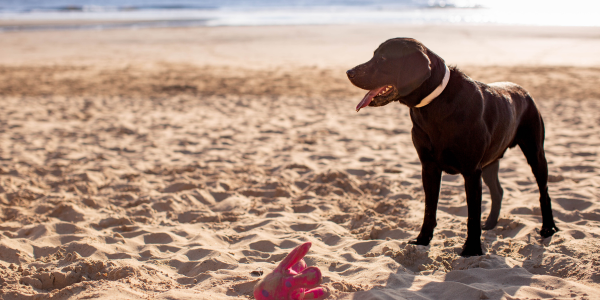As pet owners, we all want what's best for our furry friends. From providing a cozy bed to serving up the tastiest treats, ensuring their happiness and well-being is our top priority. We all know that walkies are probably your dogs favourite part of the day, and just like us, dogs need physical activity to stay healthy and happy throughout their lives. In this guide, we'll delve into the significance of regular exercise for dogs, covering both the physical and mental benefits, along with tips on how to meet your canine companion's exercise needs based on their breed and life stage.
The Physical Benefits of Regular Exercise for Dogs

Regular exercise plays a crucial role in maintaining your dog's physical health. Here are some of the key benefits:
Weight Management
Just like humans, dogs can struggle with obesity if they lead a sedentary lifestyle and consume too many calories. Regular exercise helps to burn excess calories, keeping your furry friend at a healthy weight and reducing the risk of obesity-related health issues.
Muscle Development
Engaging in physical activity helps to build and maintain muscle mass, promoting overall strength and agility in your canine companion. Strong muscles are essential for supporting joints and preventing injuries, especially in active breeds or working dogs.
The Mental Benefits of Regular Exercise for Dogs

In addition to the physical benefits, regular exercise also has a profound impact on your dog's mental well-being. Here's how:
Dog Happiness
Dogs are naturally active creatures, and regular exercise allows them to release pent-up energy and enjoy their favorite activities. A tired dog is a happy dog, and you'll often find that regular exercise leads to a more content and relaxed demeanor in your furry friend.
Socialization and Bonding
Taking your dog for walks or to the dog park provides valuable opportunities for socialization with other pets and people. These interactions help to improve your dog's social skills and strengthen the bond between you and your furry companion.
Behavioral Benefits
Dogs that receive adequate exercise are less likely to exhibit behavioral issues such as excessive barking, chewing, or digging. Physical activity helps to reduce boredom and anxiety, promoting good behavior and a harmonious household.
How Much Exercise Do Dogs Need?

The exercise requirements of dogs vary depending on factors such as breed, age, size, and overall health. Here's a general guideline for meeting your dog's exercise needs:
- Small Breed Dogs: Small breeds such as Chihuahuas or Dachshunds typically require around 30 minutes to 1 hour of exercise per day. This can include short walks, play sessions, or interactive games.
- Medium Breed Dogs: Breeds like Beagles or Bulldogs benefit from approximately 1 to 2 hours of exercise each day. This can include brisk walks, jogging, fetch, or agility training.
- Large Breed Dogs: Larger breeds such as Labrador Retrievers or Golden Retrievers need around 2 hours of exercise daily to stay healthy and happy. Activities like running, hiking, swimming, or playing fetch are ideal for these active dogs, however, they all thrive with plenty of mental stimulation.
A Dog’s Exercise Requirements Based on Life Stage

In addition to breed-specific needs, your dog's exercise requirements will also change as they age. Here's how to adapt their exercise routine based on life stage:
- Puppyhood: Puppies have boundless energy and should engage in short bursts of play and exercise throughout the day. However, it's essential to avoid overexertion and provide plenty of rest between activities to support healthy growth and development.
- Adult Dogs: Adult dogs require regular exercise to maintain their health and vitality. Aim for a combination of daily walks, playtime, and mental stimulation to keep them happy and fulfilled.
- Senior Dogs: As dogs age, their activity levels may decrease, but they still benefit from gentle exercise to keep their joints mobile and their minds sharp. Short, leisurely walks and low-impact activities like swimming or gentle games are ideal for senior dogs.
Dog Walking Must-Haves

When taking your dog for a walk, be sure to have the following essentials on hand:
- Leash and Collar: Ensure your dog is properly controlled during walks to prevent accidents or escapes. Choose a collar or harness that fits comfortably and securely. We recommend a durable fabric like leather for your collar and leash. Our new padded leather walking accessories make the perfect choice for your dog, they are handcrafted in Italy and made from the finest Italian leather - making them a durable and long-lasting choice for your dog.
- Poop Bags: Always clean up after your dog to keep public spaces clean and hygienic.
- Water and Bowl: Keep your dog hydrated during walks, especially on hot days. Bring along a collapsible water bowl and offer frequent water breaks. The Mobile Dog Gear backpacks have collapsible bowls in and are great for when you’re out and about with your dog on longer walks, they have plenty of space for all their travel essentials.
- Identification Tags: Make sure your dog wears identification tags with your contact information in case they get lost during walks.
- Treats or Toys: Use treats or toys to reward good behavior and keep your dog engaged during walks.
Conclusion
Regular exercise is essential for keeping your canine companion healthy, happy, and well-adjusted. From weight management and muscle development to mental stimulation and socialization, the benefits of regular exercise extend to every aspect of your dog's well-being. By understanding your dog's breed-specific needs and adapting their exercise routine to their life stage, you can ensure that they lead a fulfilling and active lifestyle. So lace up those walking shoes, grab your pup's leash, and embark on a journey of health and happiness together!
Remember, a happy dog is an active dog, so prioritize regular exercise as part of your pet's daily routine. With the right care and attention, you can enjoy many years of companionship and shared adventures with your beloved furry friend.

